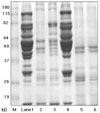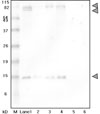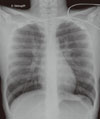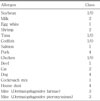Abstract
Food-dependent exercise-induced anaphylaxis (FDEIA) is a specific variant of exercise-induced anaphylaxis that requires both vigorous physical activity and the ingestion of specific foods. In particular, it is rare occurrence for FDEIA to be associated with meat in Korea. A 15-year-old female had generalized urticaria, dyspnea, severe cough, headache, dizziness, and vomiting after singing and dancing for 1 hour and after ingesting grilled pork. Skin prick tests showed a strong positive reaction to pork, whereas the results of an oral food challenge and exercise provocation tests were negative. However, the exercise provocation test after pork ingestion showed a positive reaction manifested by generalized urticaria, cough, mild dyspnea, and a 23% decreased peak expiratory flow rate. Three allergens to pork (67 kDa, 90 kDa, and 15 kDa) reacted with the patient's serum on immunoglobulin E immunoblotting. We report a case of pork-dependent exercise-induced anaphylaxis in a patient who was sensitive to pork.
Figures and Tables
 | Fig. 2Sodium dodecyl sulfate polyacrylamide gel electrophoresis analysis of pork treated with heating (10 %). M, molecular weight marker; Lane 1, raw boston butt; Lane 2, boiled boston butt; Lane 3, roasted boston butt; Lane 4, raw boned rib; Lane 5, boiled boned rib; Lane 6, roasted boned rib. |
 | Fig. 3Imunoglobulin E Immunoblotting of pork. M, molecular weight marker; Lane 1, raw boston butt; Lane 2, boiled boston butt; Lane 3, roasted boston butt; Lane 4, raw boned rib; Lane 5, boiled boned rib; Lane 6, roasted boned rib. |
References
2. Kim MK, Lee KS, Kim MS. Food (wheat flour) dependent exercise-induced anaphylaxis in asthmatics: related with the amount of wheat flour and exercise. J Asthma Allergy Clin Immunol. 1999. 19:724–729.
3. Jeon KW, Kim C, Kim YK, Kang MS, Bong JD, Ki SY, et al. A case of parsely dependent exercise-induced anaphylaxsis. J Asthma Allergy Clin Immunol. 1998. 18:728–732.
4. Yang MS, Lee SH, Kim KM, Kwon HS, Kim DI, Park CH, et al. A case report of food-dependent exercise-induced anaphylaxis to apples. Korean J Asthma Allergy Clin Immunol. 2006. 26:242–245.
5. Hong SJ, Ahn KM, Lee SY, Kim KE. The prevalences of asthma and allergic diseases in Korean children. Korean J Pediatr. 2008. 51:343–350.

6. Oh JW, Pyun BY, Choung JT, Ahn KM, Kim CH, Song SW, et al. Epidemiological change of atopic dermatitis and food allergy in school-aged children in Korea between 1995 and 2000. J Korean Med Sci. 2004. 19:716–723.

7. Jeong BY, Kim DY, Fan JP, Chung HC, Han GD. Studies on prevalence of meat allergy and potential beef allergens. J Korean Soc Food Sci Anim Resour. 2009. 29:151–156.

8. Son DY, Yoon KR, Lee SI. Study of the most common allergic foods in Korea. Korean J Food Sci Technol. 2002. 34:885–888.
9. Besler M, Steinhart H, Paschke A. Stability of food allergens and allergenicity of processed foods. J Chromatogr B Biomed Sci Appl. 2001. 756:207–228.

10. Llátser R, Polo F, De La Hoz F, Guillaumet B. Alimentary allergy to pork. Crossreactivity among pork kidney and pork and lamb gut. Clin Exp Allergy. 1998. 28:1021–1025.

11. Aihara Y, Takahashi Y, Kotoyori T, Mitsuda T, Ito R, Aihara M, et al. Frequency of food-dependent, exercise-induced anaphylaxis in Japanese junior-high-school students. J Allergy Clin Immunol. 2001. 108:1035–1039.

12. McClean SP, Arreaza EE, Lett-Brown MA, Grant JA. Refractory cholinergic urticaria successfully treated with ketotifen. J Allergy Clin Immunol. 1989. 83:738–741.

13. Barg W, Medrala W, Wolanczyk-Medrala A. Exercise-induced anaphylaxis: an update on diagnosis and treatment. Curr Allergy Asthma Rep. 2011. 11:45–51.

14. Yang PC, Berin MC, Yu LC, Conrad DH, Perdue MH. Enhanced intestinal transepithelial antigen transport in allergic rats is mediated by IgE and CD23 (FcepsilonRII). J Clin Invest. 2000. 106:879–886.

15. Lemon-Mulé H, Nowak-Wegrzyn A, Berin C, Knight AK. Pathophysiology of food-induced anaphylaxis. Curr Allergy Asthma Rep. 2008. 8:201–208.





 PDF
PDF ePub
ePub Citation
Citation Print
Print






 XML Download
XML Download